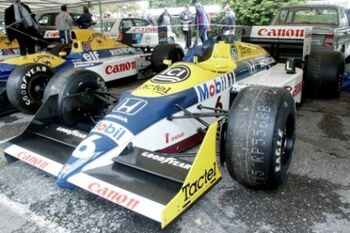
Williams Honda FW11 driven by Nigel Mansell - exits Druids corner during testing at Brands Hatch 1986, by Martin Lee - Flickr.com
The Williams FW11 was a Formula One car designed by Patrick Head and Frank Dernie as a serious challenger to McLaren and their MP4/2 car.
Development[]
The car took over from where the FW10 left off at the end of 1985, when that car won the last three races of the season. The FW11's most notable feature was the Honda 1.5 Litre V6 turbo engine, the most powerful in F1 at the time producing 800 bhp at 12,000rpm and well over 1,000 bhp in qualifying. Added to the engine's power were the aerodynamics, which were ahead of the MP4/2 and the Lotus 97T . That and its excellent driving pairing of Nelson Piquet and Nigel Mansell made it a force to be reckoned with. The car was an instantly recognisable product of the turbo era of F1.
History[]
In 1986, the car won first time out in Brazil with Piquet, before Mansell laid down a title challenge with four wins. Williams were shaken by the near fatal road crash of Frank Williams which demoralised the team, but Head stepped up and managed the team until Williams returned late in the season.
This may have caused the in-fighting between the two team mates, and the lost points helped Alain Prost take his second world championship. That and Mansell's spectacular blow out in the final race in Australia where all he had to do was finish third to win the title. The points built up between Piquet and Mansell were enough for Williams to take the constructors' championship, however.

Williams Honda FW11B, at the 2002 Goodwood Festival of Speed, by Wouter Melissen - Ultimatecarpage.com
The FW11 was updated slightly for 1987 to become the Williams FW11B, and the team made no mistakes in wrapping up both championships.
Honda were now supplying Lotus with the same engine supplied to Williams, which helped Ayrton Senna challenge consistently, but the FW11's superiority told, and Piquet finished in the points (mostly on the podium) in every race other than Spa, Imola. Where he had a terrible crash at Tamburello during Friday practice, he emerged with only a sore ankle, and he wanted to start the race but was prevented from doing so by F1 Medical boss, Prof. Sid Watkins, and when he had to retire in Belgium and Adelaide, and as a result he took out the 1987 World Championship.
As for Mansell, he scored six victories including a memorable win at the British Grand Prix. He scored twice as many wins as Piquet, but also had the lion's share of bad luck and unreliability. Piquet's third championship was assured after Mansell had a major crash during practice for the Japanese Grand Prix, meaning that Mansell could only take second place in the championship. The team tested and developed its own active suspension for the first time with the FW11B and Piquet found the car to be superior to the conventionally suspended FW11B. He first used it in competition at the Italian Grand Prix where it proved much faster allowing him to run with less wing and record the highest speed of the 1987 season when he was speed trapped at 218.807 mph (352.135 km/h), some 5 mph faster than Mansell could manage in the conventional suspension car. There were also plans in 1987 to introduce a semi automatic transmission, but this never came to pass.
The FW11 was not a technical showcase by any means, but solid engineering, the engine's outright power and Piquet and Mansell helped the car take 18 wins, 16 pole positions and 278 points over two seasons of racing.
Variants[]
An interim car that was tested before the FW11's successor FW12 was finished, the FW11C was used for the Judd V8 engine powering the FW12 in 1988. It was only built for testing purposes and it never raced.
Technical Details[]
- Class: Formula One car
- Engine: Mid-engined Honda V6 Twin-Turbos (800 HP/597 kW at 12000 RPM)
- Gearbox: 5 speed manual
- Drivetrain: Rear wheel drive (RWD)
- Weight: 540 kilograms/1190.5 lbs
- Tyres: Goodyear tyres with metallic-black coloured BBS rims
| Williams vehicles | |
|---|---|
| Classic Racecars
|
|
